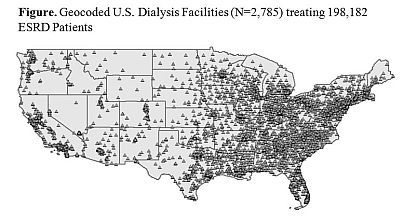Neighborhood-Level Factors Associated with Low Kidney Transplant Rates among U.S. Dialysis Facilities
Emory Transplant Center, Atlanta
Department of Epidemiology, Rollins School of Public Health, Atlanta
Department of Medicine, Renal Division, Emory University, Atlanta
Meeting: 2013 American Transplant Congress
Abstract number: 251
Background: Variability in kidney transplant rates across U.S. dialysis units has been noted, yet little is known of the association of neighborhood-level factors around dialysis facilities with low standardized transplant ratios (STRs).
Methods: We geocoded Centers for Medicare and Medicaid Services Dialysis Facility Report data and linked it with Census American Community Survey Data (2007-2010) to examine neighborhood (census tract)-level factors associated with low kidney transplant rates among U.S. dialysis facilities.

Analyses were restricted to facilities with complete 4-year STR data. Multivariable-adjusted multilevel linear regression models were used to identify the neighborhood and facility characteristics associated with low 4-year average STR.
Results: Among 2,785 U.S. dialysis facilities treating 198,182 patients, there was wide geographic variability in facility-level STRs. Median 4-year average facility-level STRs ranged from 0.61 [interquartile range (IQR): 0.36, 0.94] in Network 6 (Southeastern Kidney Council) to 1.52 (IQR: 0.95, 2.18) in Network 1 (New England). In multivariable analyses, neighborhood factors associated with low STR (p<0.001) included lower median income, lower proportion of English speakers, and a higher proportion of the population with < a high school education. No association was observed between STR and the proportion of households without a vehicle, the proportion unemployed, the proportion of black households, or neighborhood poverty.
Conclusions: There is significant variability in facility-level STRs among U.S. dialysis facilities. The characteristics of the neighborhood in which a dialysis facility resides may influence patient access to transplant, independent of dialysis facility characteristics. Understanding factors associated with low transplant rates can be used to target interventions to low-performing dialysis facilities, in neighborhoods with the highest need to improve access to kidney transplantation.
To cite this abstract in AMA style:
Patzer R, Plantinga L, McClellan A, Odewole O, Pastan S. Neighborhood-Level Factors Associated with Low Kidney Transplant Rates among U.S. Dialysis Facilities [abstract]. Am J Transplant. 2013; 13 (suppl 5). https://atcmeetingabstracts.com/abstract/neighborhood-level-factors-associated-with-low-kidney-transplant-rates-among-u-s-dialysis-facilities/. Accessed December 14, 2025.« Back to 2013 American Transplant Congress
